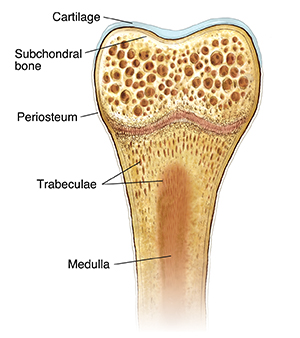Understanding Bone Bruise (Bone Contusion)
A bone bruise is an injury to a bone that is less severe than a bone fracture. Bone bruises are fairly common. They can happen to people of all ages. Any type of bone in your body can be bruised. Other injuries often happen along with a bone bruise, such as damage to nearby ligaments.
What happens when a bone is bruised?
Bone is made of different kinds of tissue. The periosteum is a thin layer of tissue that covers most of a bone. Where bones come together, there is usually a layer of cartilage at the edges. The bone here is called subchondral bone. Deep inside the bone is an area called the medulla. It contains the bone marrow and fibrous tissue called trabeculae.
With a bone fracture, all of the trabeculae in a region of bone have broken. But with a bone bruise, an injury only damages some of these trabeculae. An injury might cause blood to build up in the area beneath the periosteum. This causes a subperiosteal hematoma, a type of bone bruise. An injury might also cause bleeding and swelling in the area between your cartilage and the bone beneath it. This causes a subchondral bone bruise. Or bleeding and swelling can occur in the medulla of your bone. This is called an intraosseous bone bruise.

What causes a bone bruise?
Injury of any kind can cause a bone bruise. Sports injuries, motor vehicle accidents, or falls from a height can cause them. Twisting injuries that cause joint sprains can also cause a bone bruise. Health conditions like arthritis may also lead to a bone bruise. This is because arthritis causes bone surfaces to grind against each other. Child abuse is another cause of bone bruises.
Symptoms of a bone bruise
Symptoms of a bone bruise can include:
-
Pain and soreness in the injured area
-
Swelling in the area and soft tissues around it
-
Change in color of the injured area
-
Swelling or stiffness of an injured joint
This pain is often more severe and lasts longer than a soft tissue injury. How severe your symptoms are and how long they last depends on how severe the bone bruise is.
Diagnosing a bone bruise
Your healthcare provider will ask you about your medical history and symptoms. They will ask how you got your injury. Your provider will examine the injured area to check for pain, bruising, and swelling. After the exam, your healthcare provider may be able to tell if you have a bone bruise.
A bone bruise doesn’t show up on an X-ray. But you may be given an X-ray to rule out a bone fracture. A fracture may need a different kind of treatment. An MRI can confirm a bone bruise. But your healthcare provider will likely only give you an MRI if your symptoms don’t get better.